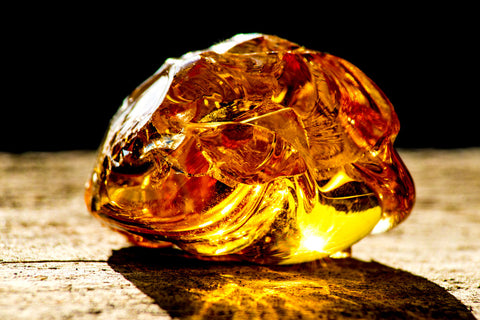Posted on 18 May 2017
The amber trade route isn't as well known as the Silk Road, but it’s just as important. It’s presumed that the trading of this gem began in the New Stone Age. First obtained in the centers of Jutland and Baltic Coast, it spread to Europe and Egypt. Amber traders collected the stone from the Baltic Coast, and the stone was moved from this coast to Southern Europe.
The first route was from the east near the Danube River to the Black Sea. Traders in these areas transported amber to the ancient Greeks. Then, the ancient Romans built an overland route to link Danube River to Italy’s Port of Aquileia. Other courses would include a sea route spanning across the Baltic and North Seas towards Britain, then to the Mediterranean and several other areas. Historians also noted that this stone traveled to Egypt after finding King Tutankhamun’s breastplate. Therefore, the Amber trade route went from the Baltic Coast to the Mediterranean, then from the Black Sea to Egypt. This stone was then carried to Asia by traders’ use of the Silk Road.
Archaeologists in 3400-2400BCE unearthed Baltic amber beads in Tethys pyramid from various pharaoh tombs. Another archaeologist, Heinrich Schliemann, found amber beads along with other artifacts when he excavated Troy in 1871 to 1890. Scientists believed these artifacts were made of amber and brought from the Baltic Coast in 3000 BCE. Heinrich also found Baltic amber in the cupola tombs in 1600-800 BCE.
Like silk, amber was one of the first gems used in long distance trades. This gem has unique characteristics making it a good stone to transport from the Baltic Sea area where amber was scarce.
In Samland, a part of the southeastern Baltic region, this gem washed up on the beach in huge quantities. During the ancient times, in areas where this gem was discovered in bountiful quantities, people couldn't understand why someone would pay for the gem since it was so accessible.
However, for those living in areas where this gem was in short supply, amber was a beauty. They used it for decoration. One of the gemstone's unusual characteristics is that it can be burned and you can smell its pine wood aroma, ergo, it ultimately earned the “Bernstein” or “burn stone.”
During the first to the third centuries, the Roman Empire and its colonies traded amber heavily, which resulted in the Amber Road. In the Greek and the Roman empires, this stone was recognized as “northern gold.” Golden and reddish amber were considered highly valuable and were used in manufacturing adornments, implements, and utensils. Opaque amber, on the other hand, was made into incense. Amber was packed in intermediate points before being transported for the Roman Empire. During the end of the third century, new amber trade routes heading east were started.

In 600 BCE, the Greeks learned that this stone could attract things when rubbed with a woolen cloth. Several speculations about this gen’s nature arose. Some claimed that this stone was a tear of a bird in India, weeping for the death of Meleager. Meanwhile, Demostatus stated that the stone was solidified urine from a lynx.
This stone is light that it wouldn’t sink in seawater, even when you put it in turbulent water it won’t sink until you throw it on a beach. Apart from the fact that it could wash up on the seashore, the stone could also be buried in a blue loam. The buoyant quality of the stone caused historians and archaeologists to be wrong about its origins. Also, some found insects and plant materials in this stone causing more difficulty in finding its origin.
In the 13th century, the amber trade changed due to high demand. In many parts of Europe people identified as Christian, which made amber rosary beads a favorite. When the Teutonic Knights conquered a kingdom in the Baltic, they acquired beaches full of amber. They declared monopoly in the collection of this stone. Anyone who was caught collecting this stone on those beaches was hanged. Under the 1264 agreement, all areas full of amber were given to the Order of the Knights of the Cross. The Sambian Archbishop received one-third of the accumulated amber in those areas. At the beginning of the 19th century, death penalties were executed on those who collected amber without the government’s knowledge or permission.
When traveling the amber road from Kaliningrad to Latvia, you can learn more about amber sources and how it’s processed. If you’re lucky, you can walk on the beach in those areas and find a piece of golden amber.
The Value of Amber
During the amber trade route, traders discovered that some of that some stones were clear while others were opaque. The stone’s opaqueness came from tiny bubbles trapped in the stone. Opaque amber has a lower value than clear amber, so to make it clear, the stone is placed in boiling water with oil, causing the bubbles to escape.
The mystery around the origins of amber was solved while the amber industry was developing. People discovered that this stone is the resin of a now-extinct pine tree that grew in Europe. The said tree released sap when injured. The sap would then be washed downstream. Over time, the resin chunks, which often contained parts of plants and insects, hardened. These chunks were then collected in the same areas where the dark soil was collected. The amber was freed after blue loam deposits eroded.
Baltic Amber Interest
Archaeologists are more interested in Baltic amber than the locally available amber. The reason for this is that Baltic amber signifies a long-distance trade. This kind of amber also contains succinic acid. By weight, authentic Baltic amber contains 2-8% of succinic acid. Testing this stone for succinic acid can be expensive. It can also damage the stone. However, in the 1960s, scientists started using infrared spectroscopy to identify real Baltic amber, to avoid damaging the stone in the process.





